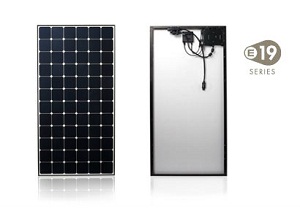SunPower introduces new residential AC solar modules at SPI
 SunPower introduced two new AC photovoltaic (PV) modules geared specifically for the residential solar market at Solar Power International. The modules, which will be available in the U.S. in early 2012, use microinverters, which should help open them up to a new market of homes that weren’t previously considered solar candidates for a number of conditions.
SunPower introduced two new AC photovoltaic (PV) modules geared specifically for the residential solar market at Solar Power International. The modules, which will be available in the U.S. in early 2012, use microinverters, which should help open them up to a new market of homes that weren’t previously considered solar candidates for a number of conditions.
The modules, the E18 (black-backed) and E19 (white-backed, more efficient) versions use SunPower’s Maxeon cell based technology, the most powerful PV cells commercially available. They integrate SolarBridge Pantheon microinverters into the panel, providing AC current at the module, rather than at a centralized inverter for an entire array.
“We see this increasing the total available market size by 20 percent,” said Rob Berry, SunPower product marketing manager.
The microinverter-integrated module can work on homes with smaller roofs, shading issues and roofs with complex angles, Berry said.
“Where it specifically increases the efficiency is with shading issues,” he said.
Shading on just one part of an array with a centralized inverter would reduce generation for the entire system. But with microinverters, the shade will only impact generation on those modules that are covered, allowing others to produce at full capacity. Microinverters can also reduce the impact of a panel mismatch on a system, according to Barry.
“We are looking at this product representing a significant portion of our 2012 output for small sites and complex roofs. We believe the demand for this product will start strong and grow steadily over time,” Berry said.
Some solar installers anticipate that such modules—other companies offer microinverter-integrated modules, like Westinghouse Solar—will make up 100 percent of their sales relatively soon, he said.
The new modules will sell for a premium over their DC E18 and E19 cousins, but their benefits lessen the impact, according to Barry.
“Based on increased energy harvest on sites with shading and the reduction in labor and permitting, this has been built, integrated, designed and listed as an AC system. From a permitting perspective, a lot of questions are answered already.”
The microinverters also report on the production capacity of each module over the Internet, allowing the homeowner and installer to visually see if any modules are producing less than expected.
“From the dealer’s perspective, they can instantly be aware of any service issues and they can pinpoint where to go in the system [to fix it],” he said.
SunPower will first roll out the products in North America, followed by Europe and then other markets like Australia, Berry said.
Image courtesy of SunPower.



